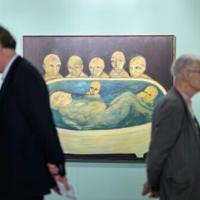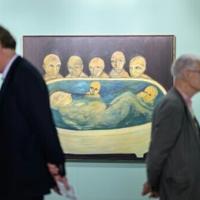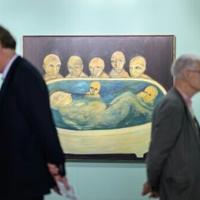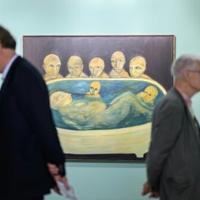Art Market
Arun Kakar
Feb 7, 2025 4:00PM
India Art Fair 2025. Courtesy of India Art Fair.
If the health of a country’s art market can be judged by the size of its largest art fair, then the 2025 edition of India Art Fair (IAF) makes for a buoyant barometer. This year’s fair, the 16th iteration, is the largest yet, hosting a record 118 exhibiting galleries and institutions (compared to 108 last year) at the NSIC Exhibition Grounds in Okhla, New Delhi.
As VIP day unfolded on a balmy Thursday afternoon, excitement was tangible among a crowd of varied ages and demographics that continued to flow well past the fair’s 11 a.m. opening. The buzzing atmosphere was due in no small part to the upward trajectory of the Indian art market in recent years—one of the most consistent green shoots we’ve witnessed during a period of uncertainty. Indian artists experienced the strongest surge in demand among nationalities on Artsy last year, and much of this spike can be attributed to the country’s growing domestic and diasporic collector bases, buffeted by the rising international profile for its leading artists. At this year’s IAF, there is a sense that this momentum is not only being maintained but expanded, too.
Advertisement
“We have a lot of international visitors this year, probably more so than the last five years,” said the fair’s director Jaya Asokan. “That really speaks to the strength of the Indian artists, South Asian artists, but also what we’ve been doing globally.” Visitors from Los Angeles and Europe were among the most sizable international visitors at this year’s fair, she added.
In another sign of its increasing international pull, the 2025 fair also welcomes first-time exhibitors such as Lagos’s kó. The gallery is presenting works by five artists from Nigeria and its diaspora, including Kwadwo A Asiedu, Bunmi Agusto, and Motunrayo Akinola. Attending the fair felt like a natural next step for the gallery, said its director Josef Gergel, who noted that kó’s founder Kavita Chellaram is herself from India. “We’ve just been really hearing so much about the fair,” Gergel told Artsy. “You see so many of the international curators and collectors and so many people coming for it, and it seems like the time is now for it to open up to a wider range of artists.”
Visitor at David Zwirner’s booth at India Art Fair 2025. Courtesy of India Art Fair.
Also returning from abroad are heavyweights David Zwirner and Lisson Gallery, which are both attending for the first time since COVID-19. David Zwirner is presenting a cleverly put-together booth that draws on both the breadth of its program as well as its connections to India. New and recent works by Huma Bhabha and Oscar Murillo are for instance shown alongside works on paper by Paul Klee—who participated in the first-ever foreign Bauhaus exhibition in 1922, which opened in India. For senior director James Green, David Zwirner’s return to the fair was a “planned hiatus” for the gallery. “We wanted to make sure we had the best projects, the best work with the artists we wanted to bring together,” he told Artsy. “As India grows its market, people are interested in having a more international conversation.”
Along with this international tilt, the key to IAF’s continued ascendancy has in recent years come from the growing level of domestic support. “People in the country are looking to support their peers,” Asokan said. “We’ve seen a real upsurge in that side of the market.” Much of this is being powered by younger generations of collectors, noted Asokan. According to The Hindu, the total number of Indian ultra-high-net-worth individuals is set to double by 2027. Notably, 20% of this cohort is under the age of 40.
Visitor at Nature Morte’s booth at India Art Fair 2025. Courtesy of India Art Fair.
“You have a lot of people putting money into art, and a lot of Indian art,” said Devashi Jain, a director of Nature Morte. “A lot of the younger generation, by seeing their parents collect or other people collect, are also becoming deeply inspired by what they’re doing.” The gallery, one of India’s leading commercial spaces, recently expanded in Mumbai. Like many galleries at the fair, it brings works by a cross-section of artists from across the spectrum of its program, from the fast-rising ultra-contemporary painter Raghav Babbar to the famed sculptor Subodh Gupta.
This prevalence of emerging artists is among the themes of this year’s fair. “Four or five years ago, there was very little in emerging art,” said Gayatri Singh, founder of Haryana gallery Art Incept, which opened in 2019 with an explicit focus on emerging art. “Over the past four years, as we’ve been showing more emerging art, there’s been a growing appetite for it—especially with younger investors,” she added, noting that such collectors are looking for lower price points. Evidencing this, the gallery’s booth was among the most crowded during the fair’s opening hours. Some of its standout works, such as a set of mythical acrylics by Ram Dongre, were priced as low as ₹22,000 ($257).
But it’s also clear that a core strength of the fair is its presentation of 20th-century artists, many of whom have increasingly attracted significant collector demand in recent years. Works by storied Indian modernists such as Sayed Haider Raza and Maqbool Fida Husain are found across the fair, at booths including Aicon and Archer Art Gallery. “These are evergreen artists,” said Manan Rella, a director at Archer Art Gallery. “[People] will never get tired of these artists because they are the ones who have shaped the modern Indian art scene.” Alongside prints by Raza and Husain, the gallery is also showing works by Thota Vaikuntam and Jyoti Bhatt, two of India’s most prominent older artists.
The enthusiasm for India’s modernists is also driving collectors to take interest in more artists from India’s past. At Dhoomimal Art Gallery, one of India’s oldest galleries, founded in 1936, abstract works by lesser-known 20th-century artists such as Bimal Dasgupta and Rajendra Dhawan are placed alongside those of heavyweights Francis Newton Souza and Husain. “People are increasingly getting more and more aware of artists that were relevant in the ’50s, ’60s, and ’70s, but for whatever reason, they’ve got critical acclaim, but not so much commercial acclaim,” said Uday Jain, Dhoomimal’s director. “I do think that that’s drastically changing, and now people are looking for a lot of these artists who have that pedigree and history but haven’t been shown as much over the years.”
Another expanding area of interest that the fair is tapping into is design. This year, IAF has invited 11 designers to participate in its design section, up from seven last year when the section launched. “We’re quite interested in that space, specifically because it stands on a 1,000-year history of tradition and craft,” said Asokan. Like many of the works across the fair, these designers are pushing forward while acknowledging tradition.
“It’s really refreshing to see that, you know, the art world and its patrons are ready for something so young and fresh and colorful,” said Nynika Jhaveri, founder and principal designer of Mumbai’s Studio Nyn. “India is very ready for it, across scale, across aesthetic, across practice.” In its booth, the studio is presenting works by Hamshangpa (Merci) Maku and Anikesa Dhing. The works are installed together in such a way that walking into the booth feels like stepping into a classy, playfully constructed living room. Dhing’s “Jibber Jabber” chairs, in particular, were being tested by weary VIPs.
Visitor at Studio Raw Material’s booth at India Art Fair 2025. Courtesy of India Art Fair.
Even while the mood at the fair is one of expansion—of scale, practices, and scope—there remains a lingering question of the fair’s recently axed development. Last September, IAF announced that it would launch a new Mumbai edition in November to run alongside Art Mumbai, which was launched in November 2023 and quickly established a foothold in a city that has more billionaires than any other in Asia. But recently, IAF announced that it was canceling the edition due to reported concerns raised by Indian galleries due to the clash of dates with Art Mumbai. Asokan pointed out that IAF has been “very committed to Mumbai” and continues to support initiatives such as Mumbai Gallery Weekend in January, along with several other events that it runs in cities across India. “I think that we just wanted to recalibrate what exactly wanted to do,” she told Artsy.
So it remains that the Delhi fair—for now—is where IAF’s energies are concentrated. And judging by its trajectory, the buzz of its VIP day, and ringing endorsements from those in attendance, that’s far from a bad thing.
For Asokan, the vision remains as ambitious as ever. “When we started 16 years ago, there was no precedent for an art fair in the country,” she said. “We worked almost institutionally because there were not that many private museums. So I think our ability to shape the narrative of the artists to look at next has been quite strong, and we hope to do that for contemporary art in the future.”
Explore India Art Fair 2025 on Artsy.
Arun Kakar
Arun Kakar is Artsy’s Art Market Editor.
This post was originally published on this site be sure to check out more of their content




